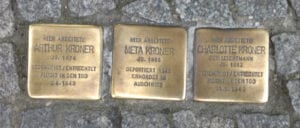Reflections on Sept. 1 of 1939 and 2016

On August 31 I returned from a trip to Frankfurt, Munich, and Berlin — the first time I had been in Germany since my husband and I left Munich in May of 1972 when my husband’s active duty commitment with the U.S. Army had been completed. When I arranged to return to the U.S. on August 31 rather than September 1, I was acutely aware that I was “getting out” of Europe before the gates slammed shut on September 1 (1939) when the Nazis invaded Poland with a fabricated provocation.
That awareness of the past in Germany was everywhere:
In Frankfurt
I learned how long Jews had lived in Germany when I visited the Museum Judengasse — a Jewish presence in Frankfurt since the mid-12th Century has been documented. And although the Jews of Frankfurt were forced into a ghetto in 1462, it appears that during the ghetto period there was much interaction between Jews and Christians. (To learn more about this fascinating museum see www.museumjudengasse.de/en/home/)
I also visited the medieval Jewish cemetery next to the Museum Judengasse. On the outer wall surrounding the cemetery is the Jewish Holocaust Remembrance Wall with almost 12,000 names in alphabetical order of the Frankfurt Jews murdered by the Nazis. Anne Frank and her sister Margot are included as they were born in Frankfurt, and their mother, Edith Frank, is also included. (I noted that the plaque for Anne Frank displays her name as “Annelies Frank.”)
In Munich
I was surprised to learn that, although the Stolpersteine commemorative stones for murdered victims of the Nazis are now appearing in many European countries besides Germany, these stones are not widespread in Munich because the head of the Jewish community in Munich is against the stones. She reportedly believes that Jews have been stepped on enough and should not be stepped on again even as commemorative stones. Yet many people disagree with her position, believing that these stones are an important reminder of what can happen when an entire nation turns to the dark side.
Read at www.stolpersteine.eu/en/ about this “art project that commemorates the victims of National Socialism, keeping alive the memory of all Jews, Roma and Sinti, homosexuals, dissidents, Jehovah’s Witnesses and victims of euthanasia who were deported and exterminated.”
In Munich I also saw the monument to the victims of Nazi tyranny on the Square of the Victims of National Socialism (the corner of Briennerstrasse and Maximilianplatz) with an eternal flame as part of the monument.
In Berlin
I last visited Berlin for a weekend in 1971 and, as my husband and I both had security clearances, we could not go into East Berlin then. Now the city is reunited and every part of the city is accessible.
This time I even took an English-guided tour of the Stasi Museum (see www.stasimuseum.de/en/enindex.htm) which reinforced how accurately my husband and I had portrayed the East German secret police in our screenplay THE WIDOW SPRINGER.
Of course I visited the two memorials in Berlin that I wrote about in a previous post:
- The first is the Memorial to the Murdered Jews of Europe designed by architect Peter Eisenman and engineer Buro Happold.
- The second is the Memorial to the Sinti and Roma Victims of National Socialism designed by Israeli artist Dani Karavan.
One of the important sites in Berlin is the documentation center the Topography of Terror at the site of the SS and Gestapo headquarters. Here are large outdoor panels tracing the rise of the Nazis and the subjugation and murder of the victims. (There is also an indoor exhibition that I did not see.) Read more at www.topographie.de/en/
And of course there is the amazing Jewish Museum in Berlin (www.jmberlin.de/main/EN/homepage-EN.php). Here is a description of the museum from the architect Daniel Libeskind’s site:
The Jewish Museum Berlin, which opened to the public in 2001, exhibits the social, political and cultural history of the Jews in Germany from the fourth century to the present, explicitly presenting and integrating, for the first time in postwar Germany, the repercussions of the Holocaust. The new building is housed next to the site of the original Prussian Court of Justice building which was completed in 1735 [and] now serves as the entrance to the new building.
Daniel Libeskind’s design, which was created a year before the Berlin Wall came down, was based on three insights: it is impossible to understand the history of Berlin without understanding the enormous contributions made by its Jewish citizens; the meaning of the Holocaust must be integrated into the consciousness and memory of the city of Berlin; and, finally, for its future, the City of Berlin and the country of Germany must acknowledge the erasure of Jewish life in its history.
Yet for all the memorials to the victims that I saw in Germany, I can never forget that, on September 1, 1939, as the gates of Europe swung closed — the fate of six million Jews and so many more millions of victims was sealed. NEVER AGAIN!
© 2016 Miller Mosaic LLC


Very interesting.
See you tomorrow.